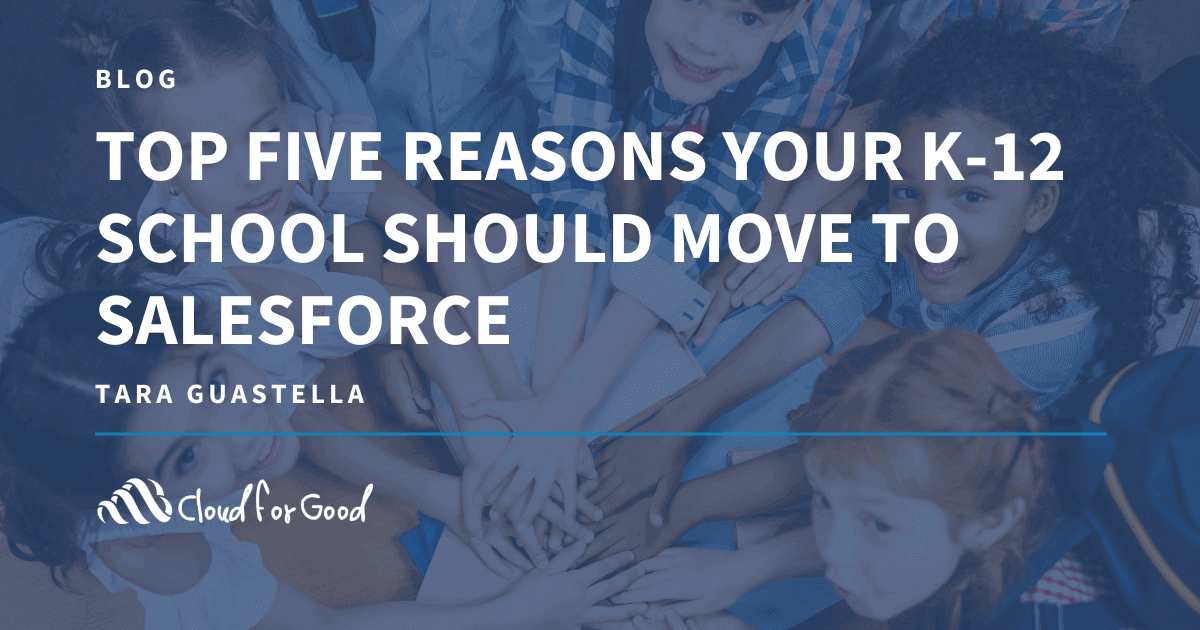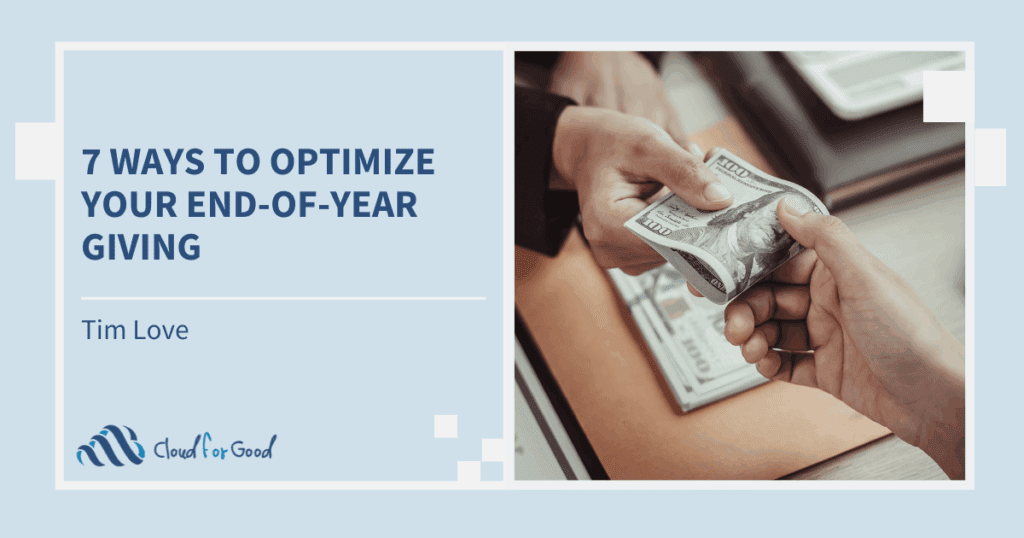“Before our engagement with Cloud for Good and the migration to Salesforce, there was a lot of anecdotal information logged in our system, but there was not a clearly defined way to use that data. We needed a system that could help us be more systematic and strategic in how we were using our data and offered a way to visualize and share that data with others,” noted Vidya Kagan, Director of Data Management & Research at Menlo School.
Kagan’s experience is not unusual. Each day we hear from organizations that do not have a clearly defined path for using the data they collect on an ongoing basis. Whether you work in recruitment, admissions, student success, development, alumni management, or another department within a K-12 school (public, private, charter, or otherwise), you should consider these five reasons to consolidate systems and make the move towards a single, stable Constituent Relationship Management (CRM) platform like Salesforce.
5. Break Down Data Silos
Within one school, how many data systems can you have? The answer to this question varies from school to school and usually it is more than one system. From recruiting students to following them through their post-graduation and alumni years, most schools are not alone in tracking data from various time points in different systems. Many schools have one system for recruitment and admissions, another for student information (often referred to as a Student Information System, or SIS), potentially a separate system for intervention or case management (though this may be included in the SIS) and possibly a separate system for development, alumni relations, and events. In addition to the aforementioned systems, most schools also have a communications mechanism (email marketing platform, social media platforms, and/or a marketing automation tool) and still maintain Excel spreadsheets, which hold more supplemental information than what is found in each of the siloed databases.
Salesforce can not only replace a number of these databases, but it can also integrate with systems that you may not want to replace, such as a SIS, like PowerSchool, or an email marketing tool like MailChimp or Pardot. Salesforce has robust capabilities allowing your school to break down walls, while effectively managing your students, families, and other constituencies in one organization-wide database.
4. Communicate More Effectively with Students and Parents
Once you can effectively break down silos and run all aspects of your school directly from Salesforce, you will find communicating with students and parents becomes a more streamlined process. Let’s say you want to send out a series of communications to newly enrolled families encouraging them to complete needed information and participate in upcoming events. A marketing automation tool connected to Salesforce can help you target these families and communicate with them based on past actions taken. If families are behind on submitting required documentation needed for enrollment (medical forms, birth certificates, etc.), you can continue to target them via an email campaign that is preset and easy for an administrator to execute with the click of a button. Rather then spending hours sending one-on-one emails to each family, you can create automated campaigns with your Salesforce data to do the work for you!
In another example, there is an upcoming event for parents of fifth grade students. Rather than having to pull information from various systems to send out an invitation, creating a segmented list, sending out a mass communication (via integration of a mass email tool), tracking responses, and managing event logistics can all be accomplished within Salesforce.
3. Raise More Funds
If you work in development or alumni relations, you may have utilized, or are currently using, Raiser’s Edge or DonorPerfect to manage gifts. While these solutions allow for fundraising management, they do not have features to manage other aspects of your school.
Salesforce can not only process and manage gifts, but it also provides the framework to help you raise more funds for your school. As Vidya Kagan, Director Data Management and Research at Menlo School, stated in a recent webinar, “My annual fund director texted me shortly after our Salesforce deployment telling me how much she loves Salesforce and loves using it on her phone!” The mobile aspect of Salesforce is incredibly valuable for all staff using the platform, but it is an asset to a development team who needs to access donor or alumni information when on the road. Your development team will no longer have to wait to get back to the office to make important notes or create action items for next steps with donors.
Using data to drive strategy is something else Kagan highlighted in her webinar. From a development perspective, knowing how much you raise and from what sources, can help fundraisers more strategically target their efforts. Kagan explained how using dashboards to measure grade level volunteer fundraisers is creating some “friendly competition” between the team members. These dashboards show the progress of each grade level volunteer, displaying a real-time representation of the amount of actual funds raised versus their goal.
2. Serve More Students
To grow and expand as a private, charter, or public K-12 school, it’s essential to have a solid system in place to handle additional students and families. For example, as your school expands recruitment efforts you’ll need a system that can effectively target leads and nurture them to ensure that the right students and families enter your school. If you are planning to expand your admissions procedures (applications, interviews, shadow days, school tours, etc.), you’ll need a system that can handle tracking each of these tasks and actions for each prospective student. As your classes or educational offerings expand, you’ll need a system that can effectively track those new offerings (and/or integrate effectively with your SIS). Serving more students and managing that data can be simplified by implementing this scalable, configurable cloud platform.
1. Ensure Students Receive the Best Education Possible
As a K-12 school, your number one goal is to ensure students receive an excellent education. Salesforce.org states that 89% of schools using Salesforce have improved their ability to meet their missions. By removing data barriers and targeting your constituent base in the right manner, your school can more effectively ensure that students receive the education they deserve. Having a full picture on each student and family, ensures staff can better manage student interventions, cases, schoolwork, and help students effectively make it to (and through) high school and beyond.
Cloud for Good can help your school get started with Salesforce and help you begin your journey to becoming a Connected School. We have experience with various types of schools who have implemented Salesforce for development, alumni management, admissions, student success, and more.
Contact us today to learn more!
You may also be interested in reading:
- Menlo School: From Raiser’s Edge to a Connected School
- Salesforce Analytics 101: Organizing Your Reports and Dashboards
- Burst Your Silos and Become a Connected Nonprofit





